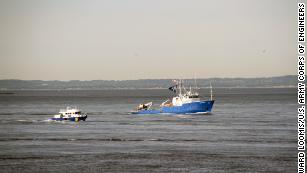
Drew F. Lawrence, Konstantin Toropin
Thu, June 16, 2022
The Department of Justice filed an appeal last week in an effort to overturn a judgment that found the Air Force 60% responsible for the events surrounding a 2017 church shooting in which a service veteran killed 26 people and injured dozens of others. It was the deadliest mass shooting in Texas history.
The ruling ordered that the federal government pay victims and their families $230 million in compensation for not flagging the shooter to the National Instant Criminal Background Check System (NICS) after he made threats of violence to his Air Force superiors, assaulted his wife and child, attempted to smuggle firearms onto Holloman Air Force Base in New Mexico, and escaped from a behavioral health facility while awaiting court-martial in 2012.
The judge in the trial, Judge Xavier Rodriguez, wrote in a July 2021 ruling that "had the Government done its job and properly reported [the shooter's] information into the background check system -- it is more likely than not that [the shooter] would have been deterred from carrying out the Church shooting."
The shooter purchased weapons between 2014 and 2017, according to CNN, two years after he was court-martialed for the assault.
Shortly after the shooting, the Air Force also acknowledged that "had his information been in the database, it should have prevented gun sales to [the shooter]."
Now, in the wake of the Uvalde shooting that killed 21 at a school, 19 of whom were elementary-age children, the DOJ is fighting the ruling that found the government culpable for the 2017 shooting that took place at the Sutherland Springs church, according to court documents, though it is unclear whether the appeal is aimed at reducing the compensation or disputing the government's overall culpability.
Some of the survivors of the shooting continue to struggle through medical consequences today. Military.com reached out to one of the victims' parents, Chancie McMahan. McMahan is the mother of Ryland Ward, who was severely wounded during the shooting.
McMahan could not speak at length with Military.com because she was with her 10-year-old as he prepared for surgery to attempt to fix injuries sustained during the shooting.
Ward, who was five years old at the time of the shooting, sustained four gunshot wounds, with one wound causing severe blood loss. Among other severe injuries, his femur was fractured in several places, an injury that required extensive surgery.
"Even after extensive physical therapy, [Ward] cannot make full use of his left arm or leg," Rodriguez's ruling said, "because the injuries to his hip and femur destroyed his growth plate, [Ward's] leg will not grow from the hip."
Last week's legal filings gave no indication as to what argument the Department of Justice planned to make in its appeal or what issue it had with the way the case was initially tried. However, coverage of the trial from November 2021 -- before the judge's ruling was issued -- suggests that the government's lawyers were balking at the possibility of having to pay the $400 million the families felt they were owed. Instead, they offered about $31 million.
A Justice Department spokesperson, Dena Iverson, confirmed that the department filed the appeal, adding "by filing this notice, the government continues its close review of the legal issues presented."
"The Department is dedicated to doing everything in its power to prevent senseless gun violence that continues to take countless innocent lives," she told Military.com via email. She also noted that the DOJ will work with courts to reach a resolution, "including possible mediation or settlement."
The February ruling issued by Rodriguez allocated a collective $230 million to victims and their families after the shooting and said that "the Court concluded that the Government failed to exercise reasonable care in its undertaking to submit [the shooter's] criminal history to the FBI," adding that the government was 60% responsible for the incident.
Then-Secretary of the Air Force Heather Wilson acknowledged the service's failings in response to the shooter's threats and domestic violence while he was still in the service.
In a hearing at the Senate Judiciary Committee in 2017, she said, "It was clear very early that [the shooter's] criminal history was not reported. And it should have been," adding that the failure to report these crimes was not an anomaly for the Air Force. Wilson also referenced a 2015 Department of Defense Inspector General report that found that between 2010 and 2012 hundreds of fingerprints were missing from the Air Force and Navy's convicted offenders list meant to be shared with the FBI. The IG could not determine the Army's compliance due to "data validation limitations."
The shooter received a "bad-conduct" discharge, was jailed for one year, and reduced to the rank of E-1 after assaulting his wife and child in 2012.
The FBI states that, under the NICS program, firearms cannot be sold to "a person convicted in any court of a misdemeanor crime which includes the use or attempted use of physical force or threatened use of a deadly weapon and the defendant was the spouse … by a person with whom the victim shares a child in common." Other prohibitive categories include, in part, being "involuntarily committed to a mental institution" or the subject of a protective order against a spouse or child.
The shooter died from a self-inflicted gunshot wound after the attack.
Rodriguez awarded more than $10 million to Ward for "disfigurement," as well as physical and mental anguish sustained during the shooting, accounting for any pain he may feel in the future.
McMahan told San Antonio's KSAT television station that the cost of medical bills and time needed to take off work to care for the 10-year-old during his extensive recovery was taking a financial toll on the family.
"You know I'm panicking because I don't know what I'm going to do because I'm not getting any help," McMahan said.
-- Drew F. Lawrence can be reached at drew.lawrence@military.com. Follow him on Twitter @df_lawrence.
-- Konstantin Toropin can be reached at konstantin.toropin@military.com. Follow him on Twitter @ktoropin.
Related: Air Force Ordered to Pay More Than $230M in Church Shooting




























